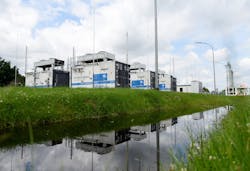Uniper, Shell to produce Blue Hydrogen at UK power station
Uniper and Shell have signed an agreement to produce blue hydrogen at Uniper’s Killingholme power station site in England.
The hydrogen produced at the site in the East of England will be used to decarbonize transport, power and industry in the Humber region. Blue hydrogen is a term used when the H2 is produced by carbon-intensive methods, such as steam reforming of natural gas methane, but is decarbonized via carbon capture and storage or other emission reduction technologies.
The Humber Hub Blue Project includes a blue hydrogen production facility with capacity of approximately 720 MW, using gas reformation technology with carbon capture and storage. The carbon captured through the process will be fed through a proposed Zero Carbon Humber onshore pipeline.
This pipeline is part of the East Coast Cluster – one of the two carbon capture and storage schemes that have received government support under the Cluster Sequencing Process.
More on H2
Plug Power supplying Green Hydrogen for Walmart H2-powered Lift Trucks at Distribution Centers
Ameresco joins team for Hydrogen Pilot Project for Heavy Duty Cargo
The Humber Hub Blue Project is eligible for the Phase-2 of the Government’s Cluster Sequencing Process. The Phase-2 projects are expected to make final investment decisions from 2024 and be operational from 2027.
Shell and Uniper will begin process design studies and site development activity.
“The Humber Hub Blue Project is a key part of Uniper’s hydrogen ambitions in the UK and we’re extremely pleased that Shell is joining us on this initiative,” Uniper Hydrogen CEO Axel Wietfeld said.
The Killingholme facility is expected to see the capture of an estimated 1.6 million metric tons of carbon annually through CCS. It will contribute to the government’s target of capturing 10Mt of carbon annually by 2030.
About the Author
EnergyTech Staff
Rod Walton is head of content for EnergyTech.com. He has spent 17 years covering the energy industry as a newspaper and trade journalist.
Walton formerly was energy writer and business editor at the Tulsa World. Later, he spent six years covering the electricity power sector for Pennwell and Clarion Events. He joined Endeavor and EnergyTech in November 2021.
He can be reached at [email protected].
EnergyTech is focused on the mission critical and large-scale energy users and their sustainability and resiliency goals. These include the commercial and industrial sectors, as well as the military, universities, data centers and microgrids.
Many large-scale energy users such as Fortune 500 companies, and mission-critical users such as military bases, universities, healthcare facilities, public safety and data centers, shifting their energy priorities to reach net-zero carbon goals within the coming decades. These include plans for renewable energy power purchase agreements, but also on-site resiliency projects such as microgrids, combined heat and power, rooftop solar, energy storage, digitalization and building efficiency upgrades.
